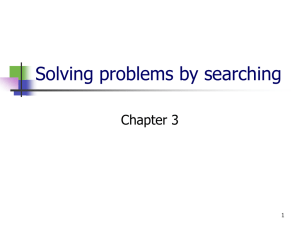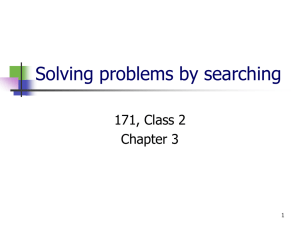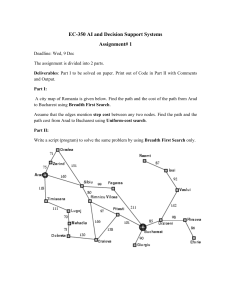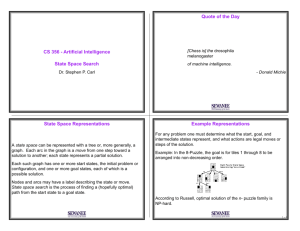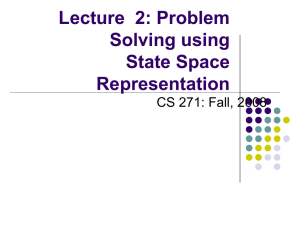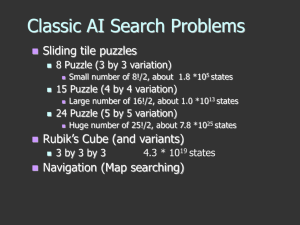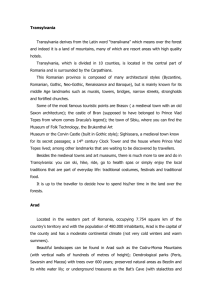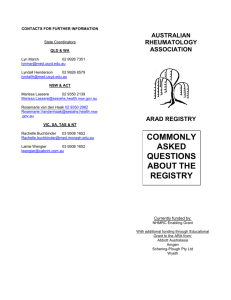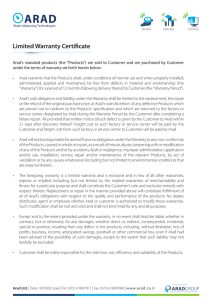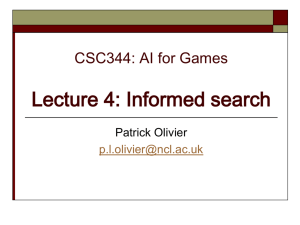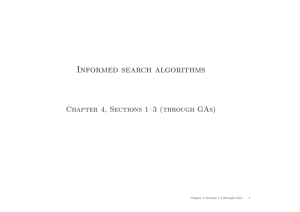Solving problems by searching
advertisement
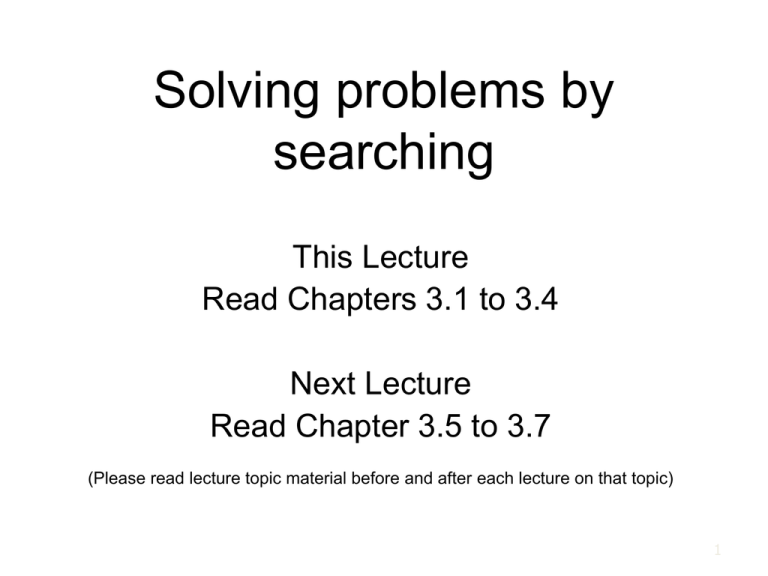
Solving problems by
searching
This Lecture
Read Chapters 3.1 to 3.4
Next Lecture
Read Chapter 3.5 to 3.7
(Please read lecture topic material before and after each lecture on that topic)
1
You will be expected to know
• State-space search
– Definitions of a problem and of a solution
– State-space graph
• Tree-search (don’t remember visited nodes) vs.
Graph-search (do remember them)
• States vs. nodes; node implementation
• Search strategy evaluation:
– Complete? Time/space complexity? Optimal?
– Parameters: b, d, m
2
Complete architectures for
intelligence?
• Search?
– Solve the problem of what to do.
• Logic and inference?
– Reason about what to do.
– Encoded knowledge/”expert” systems?
– Know what to do.
• Learning?
– Learn what to do.
• Modern view: It’s complex & multi-faceted.
Search?
Solve the problem of what to do.
• Formulate “What to do?” as a search problem.
– Solution to the problem tells agent what to do.
• If no solution in the current search space?
– Formulate and solve the problem of finding a search
space that does contain a solution.
– Solve original problem in the new search space.
• Many powerful extensions to these ideas.
– Constraint satisfaction; means-ends analysis; planning;
game playing; etc.
• Human problem-solving often looks like search.
Why Search?
• We are engaged in a bigger more important problem,
and we hit a search sub-problem we need to solve.
– We need to search in order to solve it and then get back
quickly to what we really wanted to do in the first place.
• To predict the result of our actions in the future.
• There are many sequences of actions, each with its
utility; we wish to maximize our performance measure.
• We wish only to achieve a goal; by any means at all.
• We wish to find the best (optimal) way to achieve it.
5
Example: Romania
• On holiday in Romania; currently in Arad.
• Flight leaves tomorrow from Bucharest
• Formulate goal:
– be in Bucharest
• Formulate problem:
– states: various cities
– actions: drive between cities or choose next city
• Find solution:
– sequence of cities, e.g., Arad, Sibiu, Fagaras,
Bucharest
6
Example: Romania
7
Environments Types
• Static / Dynamic
Previous problem was static: no attention to changes in environment
• Observable / Partially Observable / Unobservable
Previous problem was observable: it knew initial state.
• Deterministic / Stochastic
Previous problem was deterministic: no new percepts
were necessary, we can predict the future perfectly given our actions
• Discrete / continuous
Previous problem was discrete: we can enumerate all possibilities
8
Why not Dijkstra’s Algorithm?
• Dijkstra’s algorithm inputs the entire graph.
– We want to search in unknown spaces.
– Essentially, we want to combine search with exploration.
– E.g., an autonomous rover on Mars must search an unknown space.
• D’s algorithm takes connections as given.
– We want to search based on agent’s actions, with unknown connections.
– E.g., a Web-crawler may not know what further connections are available
on an unexplored URL before visiting it.
– E.g., the agent may not know the result of an action before trying it.
• D’s algorithm won’t work on infinite spaces.
– We want to search in infinite spaces.
– E.g., the logical reasoning space is infinite.
– E.g., the real world is essentially infinite to a human-size agent.
9
Example: vacuum world
• Observable, start in #5.
Solution?
10
Example: vacuum world
• Observable, start in #5.
Solution?
[Right, Suck]
11
Vacuum world state space graph
5
12
Example: vacuum world
• Unobservable, start in
{1,2,3,4,5,6,7,8} e.g.,
Solution?
13
Example: vacuum world
• Unobservable, start in
{1,2,3,4,5,6,7,8} e.g.,
Solution?
[Right,Suck,Left,Suck]
14
15
Problem Formulation
A problem is defined by five items:
1. initial state e.g., "at Arad“
2. actions Actions(s) = set of actions available in state s
3. transition model Result(s,a) = state that results from action a in state s
(alternative: successor function) S(s) = set of action–state pairs
e.g., S(Arad) = {<Arad Zerind, Sibiu, Timisoara>, … }
4. goal test, e.g., s = "at Bucharest”, Checkmate(s)
5. path cost (additive) e.g., sum of distances, number of actions executed, etc.
– c(x,a,y) is the step cost, assumed to be ≥ 0, summed to yield path cost
A solution = sequence of actions leading from initial state to a goal state
16
Selecting a state space
• Real world is absurdly complex
state space must be abstracted for problem solving
• (Abstract) state set of real states
• (Abstract) action complex combination of real actions
– e.g., "Arad Zerind" represents a complex set of possible routes, detours,
rest stops, etc.
• For guaranteed realizability, any real state "in Arad” must get to some
real state "in Zerind”
• (Abstract) solution set of real paths that are solutions in the real world
• Each abstract action should be "easier" than the original problem
17
Vacuum world state space graph
•
•
•
•
•
states? discrete: dirt and robot location
initial state? any
actions? Left, Right, Suck
goal test? no dirt at all locations
path cost? 1 per action
18
Example: 8-Queens
• states? -any arrangement of n<=8 queens
•
•
•
•
-or arrangements of n<=8 queens in leftmost n
columns, 1 per column, such that no queen
attacks any other (BETTER!!).
initial state? no queens on the board
actions? -add queen to any empty square
-or add queen to leftmost empty square, such that
it is not attacked by other queens (BETTER!!).
goal test? 8 queens on the board, none attacked.
path cost? 1 per move (not really relevant)
19
Example: robotic assembly
• states?: real-valued coordinates of robot joint
angles parts of the object to be assembled
• initial state?: rest configuration
• actions?: continuous motions of robot joints
• goal test?: complete assembly
• path cost?: time to execute+energy used
20
Example: The 8-puzzle
•
•
•
•
•
states?
initial state?
actions?
goal test?
path cost?
Try yourselves
21
Example: The 8-puzzle
•
•
•
•
•
states? locations of tiles
initial state? given
actions? move blank left, right, up, down
goal test? goal state (given)
path cost? 1 per move
[Note: optimal solution of n-Puzzle family is NP-hard]
22
Tree search algorithms
• Basic idea:
– Exploration of state space by generating successors
of already-explored states (a.k.a.~expanding states).
– Every generated state is evaluated: is it a goal state?
23
Tree search example
24
Tree search example
25
Tree search example
We will visit the
Note that we come
back to Arad often,
wasting time&work
same node often,
wasting time&work
26
Repeated states
• Failure to detect repeated states can turn a
linear problem into an exponential one!
• Test is often implemented as a hash table.
27
Solutions to RepeatedS States
B
S
B
C
C
C
S
B
S
State Space
Example of a Search Tree
• Graph search
faster, but memory inefficient
– never generate a state generated before
• must keep track of all possible states (uses a lot of memory)
• e.g., 8-puzzle problem, we have 9! = 362,880 states
• approximation for DFS/DLS: only avoid states in its (limited)
memory: avoid infinite loops by checking path back to root.
– “visited?” test usually implemented as a hash table
28
Implementation: states vs. nodes
• A state is a (representation of) a physical configuration
• A node is a data structure constituting part of a search tree
contains info such as: state, parent node, action, path cost
g(x), depth
• The Expand function creates new nodes, filling in the various
fields and using the SuccessorFn of the problem to create
the corresponding states.
29
Search strategies
• A search strategy is defined by picking the order of node
expansion
• Strategies are evaluated along the following dimensions:
–
–
–
–
completeness: does it always find a solution if one exists?
time complexity: number of nodes generated
space complexity: maximum number of nodes in memory
optimality: does it always find a least-cost solution?
• Time and space complexity are measured in terms of
– b: maximum branching factor of the search tree
– d: depth of the least-cost solution
– m: maximum depth of the state space (may be ∞)
30
Summary
• Generate the search space by applying actions to the
initial state and all further resulting states.
• Problem: initial state, actions, transition model, goal test,
step/path cost
• Solution: sequence of actions to goal
• Tree-search (don’t remember visited nodes) vs.
Graph-search (do remember them)
• Search strategy evaluation: b, d, m
– Complete? Time? Space? Optimal?
